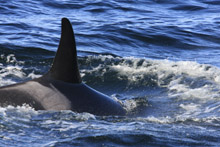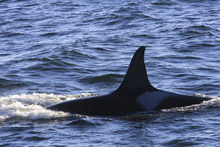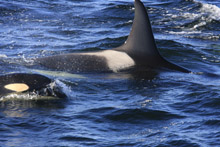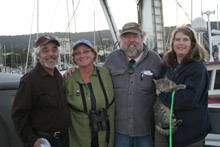|
Monterey, CA. Today, February 10, 2011, members of the endangered group
of Resident Killer Whales were spotted by Monterey Bay Whale Watch, headed
into Monterey Bay along the deep submarine canyon. The group consisted
of "L Pod" a family group of 40 individuals, part of the population of
Southern Residents consisting of J, K and L pods. These whales spend most
of the year off the San Juan Islands in Washington State feeding on salmon
in the inland waterways. These whales have been recently listed as endangered
as their population has decreased most likely due to a reduction in their
primary food source, Chinook salmon. Today's afternoon group of whale
watchers were absolutely thrilled as our boat searched north along the
canyon edge for gray whales, most common at this time, but instead our
naturalist, Lori Beraha, spotted a distant splash, nearly 2 miles in the
distance. It turned out our captain, Richard Ternullo, had navigated the
boat right towards the Resident Killer whales, which were seen the day
before off San Francisco. Our friend and colleague, MJ Schramm who works
for the Gulf of the Farallones National Marine Sanctuary, called us after
she received a report about the whales off San Francisco and sent a photo,
which confirmed they were the Southern Residents. We were hoping they
might be headed our way and luckily were correct! Several passengers said
it was a trip of a lifetime for them and they never imagined they would
see so many killer whales!
Nancy Black, marine biologist with Monterey Bay Whale Watch first sighted
and identified the Residents in Monterey Bay during the winter of 2000
and these whales have been sighted at least once in Monterey Bay each
winter since then. Nancy has been researching three different populations
or types of Killer Whales in Monterey Bay for nearly 25 years. These three
types of killer whales include:
1) "mammal hunters" or "Transients" that are found in small matrilineal
(adult female with offspring) groups, feed only on marine mammals from
seals to whales and are frequently sighted in Monterey Bay with a larger
range along the west coast;
2) "fish hunters" or "Residents", specifically the endangered Southern
Residents (J, K, and L pods) that feed only on fish and venture in outer
waters as far south as Monterey Bay during winter, and occur in larger
family groups up to 90 whales; and the least known
3) "Offshore Type" , found in large dispersed groups (50+), composed of
one population that ranges along the entire west coast, and feeds on fish,
sharks, and squid.
Ken Balcomb, director of the Center
for Whale Research in Friday Harbor, Washington, a location where
the Southern Residents occur nearly daily during summer months, has been
a guest of Monterey Bay Whale Watch over the last several days in his
hopes of spotting the Residents in Monterey Bay. Although Ken is known
as the "father" of killer whales as he has studied them longer than anyone
and has followed this particular group of whales since 1976, resulting
in the longest study of any whale population in the world, he has never
seen them off our coast in winter. His house even sits in a prime location
on the coast of Friday Harbor to spot the whales as they travel back and
forth during summer feeding on salmon. When Ken first started his study,
salmon were very abundant but have since drastically decreased in numbers,
causing strong concern for the survival of the killer whales depending
on them. Since Nancy first sighted these whales in 2000 in Monterey Bay
and they were not seen previously, it appears that the whales expanded
their range into new waters in search of their primary prey.
Ken said after getting off our boat today, "Thanks Lori - for first spotting
them, and, thanks L Pod for being perfectly on schedule. Wow! This is
the first time I have seen the Southern Residents in California but I
hope not the last. We must collect prey and fecal samples in the future
encounters." Ken has tried for several years to sight these particular
whales in the winter, as he needs to learn more about their winter feeding
habits. Since these whales are endangered, it is of critical importance
to study them year-round to determine if they are successfully finding
prey, what type of prey they are catching and if that prey population
is abundant enough to support the whale population. What is clear now
is that Chinook Salmon numbers are drastically low everywhere along the
west coast due to habitat destruction and water diversion and if the whales
are to recover then strong measures need to be implemented to protect
the salmon. Monterey Bay Whale Watch strongly supports researchers such
as Ken and provides information to many researchers from information gathered
on our whale watching trips to help in the effort to learn more about
various populations of endangered whales.
Click on small photos below to see enlarged photos taken today (Feb. 10)
by naturalist Lori Beraha. Check our sightings
for daily updates, as we will continue to monitor these whales and post
our sightings.
Related Articles
Southern Resident Killer Whales Sighted in Monterey
Bay in March 2003
Killer Whales from Puget Sound Observed in Monterey
Bay in February 2000
Related Website
Center for Whale
Research in Friday Harbor
|
|
![]()






